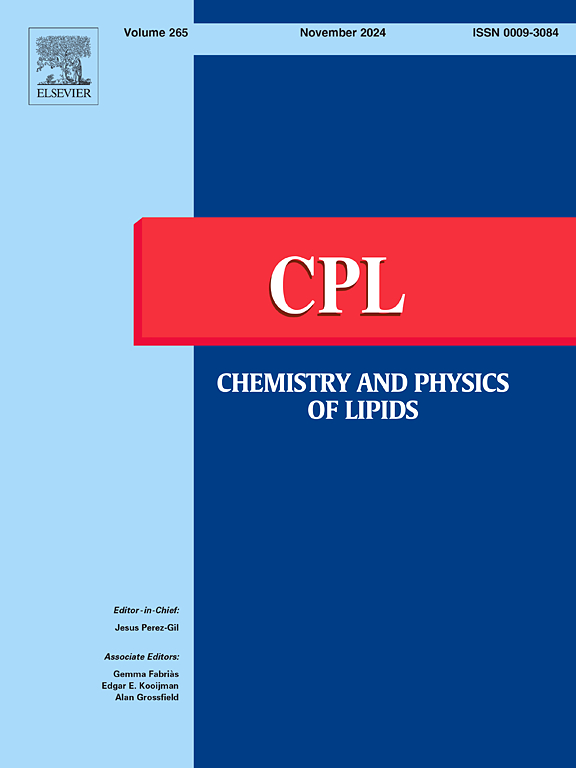RAW264.7细胞中硝基脂肪酸的脂膜行为及其装载到脂质体中激活Nrf2通路对细胞内NO生成的影响
IF 2.8
3区 生物学
Q2 BIOCHEMISTRY & MOLECULAR BIOLOGY
引用次数: 0
摘要
硝基脂肪酸(NO2-FAs)是内源性亲电信号调节剂,其中一些已被提出作为候选药物。主要有硝基油酸(NO2-OA)和硝基亚油酸(NO2-LA)等不饱和脂肪酸衍生物。在这项研究中,我们用分子动力学和选择的实验方法描述了9/10-NO2-OA、10-NO2-LA和共轭硝基亚油酸(9/12-NO2-cLA)在模型POPC(1-棕榈酰-2-油酰- asn -甘油-3-磷胆碱)膜中的行为。我们发现,与水环境中的自由分子形式相比,当装载在脂质体中时,NO2-FAs在非常有限的程度上进行降解(衰变反应)。通过对NO自由基释放的电子顺磁共振光谱分析证实了这一点。一般来说,NO2-FAs抑制膜水合作用,特别是在酯基所在的部分。此外,在NO2-FAs存在下,膜流动性增加,脂质有序度降低。这些影响对NO2-FAs比它们的非硝化版本更大。与极性头基团密切接触的硝基被证实存在。这导致脂质链倾斜,进而引起膜紊乱。质子化的NO2-FAs比解离的NO2-FAs更容易/更深地渗透到膜结构中,这使得膜双层表面更带负电荷。我们还发现,与POPC脂质体结合的NO2-FAs保留了激活Nrf2途径的能力。在小鼠巨噬细胞RAW264.7细胞中,血红素加氧酶-1 mRNA水平的表达增加,Keap1蛋白水平平行下降,证明了这一点。通过基因编码的G-geNOp传感器测定,NO2-FAs处理导致体外细胞内NO水平升高。只有NO2-OA,而NO2-LA或NO2-cLA没有统计学意义。结果表明,生物学上相关的NO释放可能严格依赖于NO2-FA的研究。本研究支持NO2-FAs在细胞和组织中的脂相或水相分布(共定位)的假设,这影响了它们的流动性、稳定性和生物活性。本文章由计算机程序翻译,如有差异,请以英文原文为准。
Lipid membrane behavior of nitro-fatty acids and their loading into liposomes to activate Nrf2 pathway in RAW264.7 cells with impact on intracellular NO production
Nitro-fatty acids (NO2-FAs) are endogenous electrophilic signalling modulators, and some of them have been proposed as drug candidates. The main ones include nitro-oleic acid (NO2-OA) and other derivatives of unsaturated fatty acids such as nitro-linoleic acid (NO2-LA). In this study, we describe the behavior of 9/10-NO2-OA, 10-NO2-LA and the conjugated nitro-linoleic acid (9/12-NO2-cLA) in a model POPC (1-palmitoyl-2-oleoyl-sn-glycero-3-phosphocholine) membrane using molecular dynamics and selected experimental approaches. We showed that when loaded in liposomes, NO2-FAs undergo degradation (a decay reaction) to a very limited extent, in contrast to the free molecular form in an aqueous environment. This was confirmed by the electron paramagnetic resonance spectroscopic analysis of NO radical release. In general, NO2-FAs suppress membrane hydration, especially in the segment where the ester groups are located. Further, in the presence of NO2-FAs, there is increased membrane fluidity and a decrease in the degree of lipid order. These effects are greater for NO2-FAs than for their non-nitrated versions. The presence of a nitro group in close contact with the polar head groups was confirmed. This drives the tilt of the lipid chain which in turn induces membrane disorder. Protonated NO2-FAs penetrated more easily/deeper into the membrane structure than the dissociated forms and this makes the membrane bilayer surface more negatively charged based on zeta potential measurement. We also found that NO2-FAs incorporated into POPC liposomes retained their ability to activate the Nrf2 pathway. This was documented by an increased expression of heme oxygenase-1 at the level of mRNA, with a parallel decrease in protein levels of Keap1, in murine macrophage RAW264.7 cells. The NO2-FAs treatment resulted in an increase in intracellular NO level in vitro as determined by a genetically encoded G-geNOp sensor. This was confirmed at statistically significant level only for NO2-OA, not for NO2-LA or NO2-cLA. The results indicate that biologically relevant NO release may be strictly dependent on which NO2-FA is investigated. This study supports the hypothesis that NO2-FAs are distributed (co-localized) in cells and tissues in the lipid or aqueous phase, which affects whether they are mobile, stable, and thus biologically active.
求助全文
通过发布文献求助,成功后即可免费获取论文全文。
去求助
来源期刊

Chemistry and Physics of Lipids
生物-生化与分子生物学
CiteScore
7.60
自引率
2.90%
发文量
50
审稿时长
40 days
期刊介绍:
Chemistry and Physics of Lipids publishes research papers and review articles on chemical and physical aspects of lipids with primary emphasis on the relationship of these properties to biological functions and to biomedical applications.
Accordingly, the journal covers: advances in synthetic and analytical lipid methodology; mass-spectrometry of lipids; chemical and physical characterisation of isolated structures; thermodynamics, phase behaviour, topology and dynamics of lipid assemblies; physicochemical studies into lipid-lipid and lipid-protein interactions in lipoproteins and in natural and model membranes; movement of lipids within, across and between membranes; intracellular lipid transfer; structure-function relationships and the nature of lipid-derived second messengers; chemical, physical and functional alterations of lipids induced by free radicals; enzymatic and non-enzymatic mechanisms of lipid peroxidation in cells, tissues, biofluids; oxidative lipidomics; and the role of lipids in the regulation of membrane-dependent biological processes.
 求助内容:
求助内容: 应助结果提醒方式:
应助结果提醒方式:


